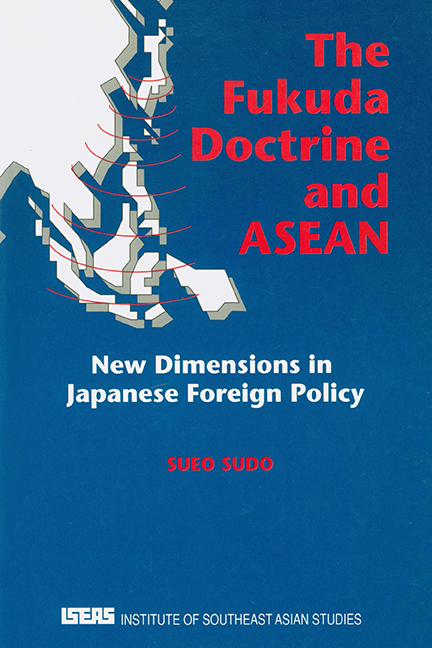Book contents
- Frontmatter
- Dedication
- Contents
- List of Tables
- Preface
- Abbreviations
- Introduction
- chapter one A Framework for Analysing Japanese Policy Towards Southeast Asia
- chapter two Post-war Japan's Re-entry into Southeast Asia
- chapter three Japan's Policy Towards Regional Development
- chapter four External Challenge and Changing Japan-Southeast Asia Relations; 1975–77
- chapter five A Changing Southeast Asia in Japanese Politics
- chapter six Formulating the First Doctrine in Japanese Foreign Policy
- chapter seven Japan's ASEAN Policy, 1977–87
- chapter eight Conclusion
- Appendices
- Bibliography
- Index
- THE AUTHOR
- Frontmatter
- Dedication
- Contents
- List of Tables
- Preface
- Abbreviations
- Introduction
- chapter one A Framework for Analysing Japanese Policy Towards Southeast Asia
- chapter two Post-war Japan's Re-entry into Southeast Asia
- chapter three Japan's Policy Towards Regional Development
- chapter four External Challenge and Changing Japan-Southeast Asia Relations; 1975–77
- chapter five A Changing Southeast Asia in Japanese Politics
- chapter six Formulating the First Doctrine in Japanese Foreign Policy
- chapter seven Japan's ASEAN Policy, 1977–87
- chapter eight Conclusion
- Appendices
- Bibliography
- Index
- THE AUTHOR
Summary
At the third Summit of the Association of Southeast Asian Nations (ASEAN) on 15 December 19877 Prime Minister Noboru Takeshita delivered a speech entitled “Japan and ASEAN: A New Partnership Toward Peace and Prosperity;”, in which he stressed three policy goals: (1) to strengthen the economic resilience of ASEAN; (2) to promote political co-ordination between Japan and ASEAN; and (3) to promote cultural exchanges. The third ASEAN Summit heralded the advent of a “special” relationship between Japan and the ASEAN countries by the fact that Japan was the only guest country among the dialogue partners of ASEAN to be invited. Since this event deserves particular scrutiny, in the pages that follow we will delve into the origins and development of this “special” relationship between Japan and Southeast Asia.
Japan's active involvement in the region can be traced back to the Fukuda Doctrine enunciated by the former Japanese Prime Minister Takeo Fukuda in August 1977. Since then, Japan's policy has been flamed systematically in order to resolve the problem of Indochina and to help Southeast Asian countries develop their economies. At the same time, the Japanese Government has been trying to forge closer links with ASEAN as a viable regional organization. It is these changes brought about by Japan's first doctrine that led Takeshita to attend the third ASEAN Summit. As a result, for the first time in the history of Japan–Southeast Asia relations, Japan has come to be regarded as a bona fide actor in this part of the world. This rare “success” in Japanese foreign policy can be readily recognized against a background of historically trouble-ridden relations.
SOUTHEAST ASIA IN JAPANESE FOREIGN POLICY
Consummating the Meiji Restoration in 18687 a newly unified Japan engaged in a vigorous aggrandizement in foreign policy epitomized in the slogan; Fukoku Kyohet (a rich nation and a powerful army).
- Type
- Chapter
- Information
- The Fukuda Doctrine and ASEANNew Dimensions in Japanese Foreign Policy, pp. 1 - 6Publisher: ISEAS–Yusof Ishak InstitutePrint publication year: 1992

